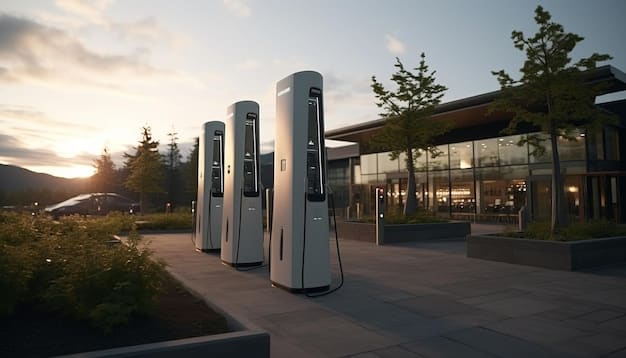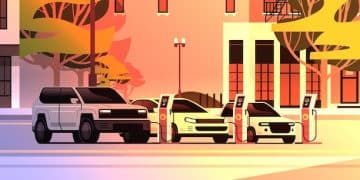EV Charging Infrastructure Growth: Impact on US Energy Demand by 2028

By 2028, the expansion of electric vehicle (EV) charging infrastructure in the US is projected to significantly increase energy demand, requiring strategic grid upgrades and potentially impacting energy sources and distribution to support the growing number of EVs on the road.
The proliferation of electric vehicles (EVs) across the United States is rapidly changing the energy landscape. A key factor in this transformation is the growth of electric vehicle (EV) charging infrastructure impact US energy demand by 2028. Understanding this impact is crucial for policymakers, energy providers, and consumers alike.
Understanding the Electric Vehicle Revolution in the US
The electric vehicle market in the US is experiencing exponential growth. This surge is driven by factors like increasing environmental awareness, government incentives, and advancements in battery technology. As more consumers switch to EVs, the demand for convenient and accessible charging solutions is intensifying.
Current State of EV Adoption
EV adoption rates are highest in states with strong environmental policies and significant incentives. California, for example, leads the nation in EV registrations. However, other states are quickly catching up as charging infrastructure becomes more widespread and affordable.
Government and Industry Initiatives
Both the government and private sector are investing heavily in EV infrastructure. The Bipartisan Infrastructure Law allocates billions of dollars to expand charging networks across the country. Automakers are also stepping up, partnering with charging companies to provide comprehensive solutions for EV owners.

- Incentives and Rebates: Many states offer rebates and tax credits to consumers who purchase EVs, further driving adoption.
- Public Awareness Campaigns: Initiatives aimed at educating the public about the benefits of EVs and dispelling common myths are also playing a crucial role.
- Infrastructure Development: Expanding charging infrastructure is essential to alleviate range anxiety and make EV ownership more practical for a wider range of consumers.
The electric vehicle revolution is not just a trend but a fundamental shift in transportation. Supporting this shift requires a concerted effort to build out the necessary infrastructure and address the challenges associated with increased energy demand.
The Expanding EV Charging Infrastructure
The backbone of the electric vehicle ecosystem is its charging infrastructure. This infrastructure encompasses a variety of charging levels and locations, each serving different needs and contributing to the overall energy demand. Understanding these components is essential for forecasting the impact on the US energy grid.
Types of Charging Stations
There are three primary levels of EV charging: Level 1, Level 2, and DC Fast Charging (also known as Level 3). Level 1 charging uses a standard 120V outlet and is the slowest option. Level 2 charging utilizes a 240V outlet and is commonly found in homes, workplaces, and public charging stations. DC Fast Charging provides the quickest charging times, often adding significant range in just 30 minutes.
Public vs. Private Charging
Charging infrastructure can be further categorized as public or private. Public charging stations are accessible to all EV owners and are typically located in commercial areas, parking garages, and along highways. Private charging, on the other hand, is primarily for residential use and may include Level 1 or Level 2 chargers installed in homes.
Investment and Growth Trends
The EV charging infrastructure market is experiencing rapid growth, fueled by substantial investments from both public and private sectors. Companies like Tesla, ChargePoint, and EVgo are leading the charge, expanding their networks and developing innovative charging solutions.
- Government Funding: Federal and state governments are providing grants and incentives to support the deployment of charging stations in underserved communities.
- Private Investments: Venture capital and private equity firms are pouring billions into EV charging companies, recognizing the long-term potential of this market.
- Technological Advancements: Innovations in charging technology, such as wireless charging and ultra-fast charging, are further accelerating the growth of the infrastructure.
The expansion of EV charging infrastructure is critical for accommodating the growing number of electric vehicles on the road. Strategic investments and technological advancements are key to building a robust and reliable charging network.
Forecasting US Energy Demand for EVs by 2028
Predicting the future energy demand of electric vehicles requires a comprehensive analysis of various factors, including EV adoption rates, charging patterns, and technological advancements. By 2028, the impact of EVs on US energy demand is expected to be significant, necessitating careful planning and grid modernization.
Factors Influencing Energy Demand
Several factors will influence the energy demand of EVs in the coming years. These include the pace of EV adoption, the efficiency of charging technologies, and the availability of charging infrastructure. Additionally, consumer behavior, such as charging frequency and location, will play a crucial role.
Projected EV Sales and Usage
Industry analysts predict a substantial increase in EV sales over the next five years. As more consumers switch to electric vehicles, the demand for electricity to power these vehicles will rise accordingly. This growth necessitates an accurate forecast of energy needs to ensure the grid can handle the additional load.
Impact on Peak Demand
One of the biggest challenges is managing peak demand. If a large number of EV owners charge their vehicles simultaneously during peak hours, it could strain the grid and lead to brownouts or blackouts. Smart charging technologies and time-of-use tariffs can help mitigate this issue.

- Smart Charging: Implementing smart charging systems that optimize charging times based on grid conditions can help distribute the load more evenly.
- Grid Modernization: Upgrading the existing grid infrastructure is essential to accommodate the increased demand from EVs.
- Energy Storage: Deploying energy storage solutions, such as batteries, can help buffer the grid and provide backup power during peak demand periods.
Forecasting the energy demand of electric vehicles by 2028 is a complex task that requires careful consideration of various factors. Strategic planning and investment in grid modernization are crucial to ensure a reliable and sustainable energy supply for the growing EV fleet.
Impact on the US Energy Grid
The integration of electric vehicles into the US energy system presents both opportunities and challenges for the existing grid infrastructure. A significant increase in electricity demand requires upgrades and adjustments to ensure stability and reliability. Understanding these impacts is vital for effective grid management.
Grid Stability and Reliability
The influx of EVs can strain the grid, particularly during peak charging times. Managing this load requires advanced grid management technologies and strategies to prevent overloading and maintain stability. Enhancements in grid monitoring and control systems are essential.
Needed Infrastructure Upgrades
Upgrading the existing grid infrastructure is crucial to accommodate the increased demand from EVs. This includes investments in transmission lines, substations, and distribution networks. Smart grid technologies can also improve efficiency and reliability.
Potential Challenges and Solutions
Several challenges may arise from the increased reliance on electricity for transportation. These include the need for more renewable energy sources, the management of peak demand, and the integration of distributed energy resources.
- Renewable Energy Integration: Increasing the share of renewable energy sources, such as solar and wind, can help reduce the carbon footprint of electric vehicles.
- Demand Response Programs: Implementing demand response programs can incentivize consumers to shift their charging habits to off-peak hours.
- Distributed Energy Resources: Integrating distributed energy resources, such as rooftop solar and battery storage, can help reduce strain on the grid.
The impact of electric vehicles on the US energy grid is multifaceted, requiring strategic investments and innovative solutions. By addressing these challenges proactively, the grid can support the growing EV fleet while maintaining stability and reliability.
The Role of Renewable Energy Sources
Integrating renewable energy sources into the EV charging infrastructure is essential for maximizing the environmental benefits of electric vehicles. By powering EVs with clean energy, the carbon footprint of transportation can be significantly reduced. This synergy between EVs and renewables is crucial for achieving sustainability goals.
Synergy between EVs and Renewables
Electric vehicles powered by renewable energy offer a compelling solution for reducing greenhouse gas emissions. By combining these technologies, the transportation sector can become more sustainable and environmentally friendly. This integration is vital for addressing climate change.
Solar and Wind Power Integration
Solar and wind power are the most promising renewable energy sources for powering EVs. Solar panels can be installed at charging stations to provide on-site electricity generation, while wind farms can supply power to the grid. These renewable sources can help reduce reliance on fossil fuels.
Sustainability and Environmental Benefits
The environmental benefits of powering EVs with renewable energy are substantial. By reducing reliance on fossil fuels, air pollution and greenhouse gas emissions can be significantly reduced. This transition can lead to cleaner air and a healthier environment.
- Reduced Carbon Footprint: Powering EVs with renewable energy can significantly reduce their carbon footprint, making them a truly sustainable transportation option.
- Cleaner Air: Shifting to electric vehicles powered by renewables can improve air quality, reducing respiratory illnesses and other health problems.
- Energy Independence: Increasing reliance on renewable energy sources can reduce dependence on foreign oil and enhance energy security.
The role of renewable energy sources in powering electric vehicles is critical for achieving a sustainable transportation system. By integrating solar and wind power into the charging infrastructure, the environmental benefits of EVs can be maximized. This transition is essential for creating a cleaner and more sustainable future.
Policy and Regulatory Considerations
Government policies and regulations play a crucial role in shaping the growth of the EV market and its impact on energy demand. Incentives, standards, and regulations can all influence the adoption rates of EVs and the development of charging infrastructure. A supportive policy environment is essential for accelerating the transition to electric mobility.
Government Incentives and Regulations
Government incentives, such as tax credits and rebates, can make EVs more affordable for consumers. Regulations, such as emission standards and fuel efficiency requirements, can encourage automakers to produce more electric vehicles. These policies can significantly impact the growth of the EV market.
Standardization of Charging Infrastructure
Standardizing charging infrastructure is essential for ensuring compatibility and convenience for EV owners. Uniform charging connectors and protocols can make it easier for drivers to charge their vehicles at any public charging station.
Grid Integration Policies
Policies that support the integration of EVs into the grid are crucial for managing energy demand and maintaining grid stability. These include time-of-use tariffs, smart charging programs, and incentives for grid modernization.
- Tax Credits and Rebates: Providing tax credits and rebates can reduce the upfront cost of EVs, making them more accessible to a wider range of consumers.
- Emission Standards: Implementing stricter emission standards can incentivize automakers to produce more electric vehicles and reduce their reliance on fossil fuels.
- Smart Charging Programs: Encouraging smart charging programs can help shift EV charging to off-peak hours, reducing strain on the grid.
Policy and regulatory considerations are fundamental to the successful integration of electric vehicles into the US energy system. By creating a supportive policy environment, the growth of the EV market can be accelerated, and the benefits of electric mobility can be realized.
| Key Aspect | Brief Description |
|---|---|
| 🚗 EV Adoption | Increased adoption drives higher energy demand for charging. |
| ⚡ Charging Infrastructure | Expansion is crucial for supporting growing EV numbers. |
| 🌍 Renewable Energy | Integrating renewables reduces the carbon footprint of EVs. |
| 💡 Grid Modernization | Upgrades are needed to handle increased EV energy demand. |
Frequently Asked Questions
▼
EV charging can increase your electricity bill, but the exact amount depends on your electricity rate, charging habits, and vehicle efficiency. Consider off-peak charging to save money.
▼
Yes, many states and the federal government offer incentives for installing home EV chargers. These can include tax credits, rebates, and other financial assistance programs.
▼
Level 2 charging uses a 240V outlet and is slower, typically adding 20-30 miles of range per hour. DC Fast Charging is much quicker, often adding 100 miles of range in 30 minutes.
▼
Use apps like PlugShare, ChargePoint, or the Tesla app to locate nearby public charging stations. These apps provide real-time information on availability and pricing.
▼
Renewable energy sources like solar and wind power can power EV charging, reducing the carbon footprint of electric vehicles and promoting a more sustainable transportation system.
Conclusion
In conclusion, as we approach 2028, the growth of electric vehicle charging infrastructure will significantly impact US energy demand. Addressing the challenges and opportunities presented by this transition requires strategic planning, investment in grid modernization, and a commitment to integrating renewable energy sources. By navigating these complexities effectively, the US can pave the way for a sustainable and electrified transportation future.





